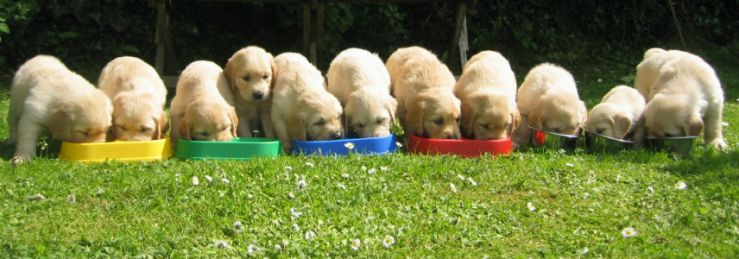
How Much Should I Feed My Puppy?
Aren’t puppies the best? They’re just the sweetest, most excitable, lovable, and downright hungry little balls of joy and fluff. The love you share for the newest four legged addition to your family is already boundless, so we understand how excited you are to keep your puppy happy and healthy.
Like infants, puppies need the proper nutrition to grow into happy and healthy adult dogs. It’s important to not only make sure that your little nugget is eating right, but that he’s also eating the appropriate portions on a healthy schedule.
Nursing
Your puppy should remain with her mother and continue nursing for the first six to eight weeks of life. Mother’s milk will absolutely provide the best source of antibodies and nutrients for newborn pups. However, if your puppy is unable to stay with her mum for the full eight weeks, use specially suited puppy formula and bottles for the remaining weeks before moving onto more solid foods.
What Should You Feed Your Puppy?
There’s no one collar size fits all when it comes choosing the right puppy or dog foods online. The best option is to discuss your breed’s needs with your veterinarian. Despite the variations between breeds and sizes, all puppies will have high nutritional and caloric needs. Select only high quality and vet recommended food brands.
Begin weening your puppy off milk and onto solid foods around six weeks by feeding her a mixture of milk/formula and puppy food. This will help your snuggle buddy’s digestive system adjust to the switch. Keep in mind that fully weening your pup may take a few weeks.
Portion Sizes
Again, healthy portion sizes will vary between breeds, so you might just want to keep your vet on speed dial. Also remember to check the packaging. The product labels of most, good quality puppy foods will include feeding guidelines based on your cutie’s age and weight.
Don’t leave your pup unchaperoned while he eats. Leaving bits of food behind after dinner could mean that your puppy feels too full, and is a sign that you might want to decrease the portion size. This will reduce the risk of him developing an overeating habit. Alternatively, if your pup seems to have an insatiable hunger, begin gradually increasing his portion sizes. Be mindful of the feeding guidelines, and careful not to overfeed. Some dogs will swallow every last bite whether they’re hungry or not.
Chow Times
Leaving food in the bowl to let your pup graze when he wants might seem easy and appealing to new dog owners, but this really isn’t an ideal feeding routine. Grazing, or free feeding, can lead to overeating habits, obesity and food aggression in adult dogs.
Scheduled feedings will keep your pup healthy, and lead to regular bowel movements; which makes house training a whole lot easier on you both! Small meals are easier for pups to digest, so begin with feeding small portions three to four times a day, making sure to feed her at the same times every day.
Most vets recommend cutting back to two meals a day once dogs reach adulthood; which again, varies from breed to breed.
The information provided by the Jumbo Pets website must not be relied upon or regarded as a substitute for specific professional advice, veterinary advice or otherwise. We make no claim that the website is 100% accurate or suitable for an individual's unique circumstance and provide the website on the basis that all persons accessing the website responsibly assess the relevance and accuracy of its content.



